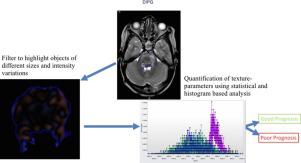Journal of Neuroradiology ( IF 3.0 ) Pub Date : 2020-03-14 , DOI: 10.1016/j.neurad.2020.02.005 Elwira Szychot 1 , Adam Youssef 2 , Balaji Ganeshan 3 , Raymond Endozo 3 , Harpreet Hyare 3 , Jenny Gains 3 , Kshitij Mankad 2 , Ananth Shankar 3

|
Background
Diffuse midline gliomas (DMG) are aggressive brain tumours, previously known as diffuse intrinsic pontine gliomas (DIPG), with 10% overall survival (OS) at 18 months. Predicting OS will help refine treatment strategy in this patient group. MRI based texture analysis (MRTA) is novel image analysis technique that provides objective information about spatial arrangement of MRI signal intensity (heterogeneity) and has potential to be imaging biomarker.
Objectives
To investigate MRTA in predicting OS in childhood DMG.
Methods
Retrospective study of patients diagnosed with DMG, based on radiological features, treated at our institution 2007–2017. MRIs were acquired at diagnosis and 6 weeks after radiotherapy (54 Gy in 30 fractions). MRTA was performed using commercial available TexRAD research software on T2 W sequence and Apparent Diffusion Coefficient (ADC) maps encapsulating tumour in the largest single axial plane. MRTA comprised filtration-histogram technique using statistical and histogram metrics for quantification of texture. Kaplan-Meier survival analysis determined association of MRI texture parameters with OS.
Results
In all, 32 children 2–14 years (median 7 years) were included. MRTA was undertaken on T2W (n = 32) and ADC (n = 22). T2W-MRTA parameters were better at prognosticating than ADC-MRTA. Children with homogenous tumour texture, at medium scale on diagnostic T2W MRI, had worse prognosis (Mean of Positive Pixels (MPP): P = 0.005, mean: P = 0.009, SD: P = 0.011, kurtosis: P = 0.037, entropy: P = 0.042). Best predictor MPP was able to stratify patients into poor and good prognostic groups with median survival of 7.5 months versus 17.5 months, respectively.
Conclusions
DMG with more homogeneous texture on diagnostic MRI is associated with worse prognosis. Texture parameter MPP is the most predictive marker of OS in childhood DMG.
中文翻译:

使用基于磁共振成像的纹理分析预测儿童弥漫性中线胶质瘤的结果
背景
弥漫性中线胶质瘤 (DMG) 是侵袭性脑肿瘤,以前称为弥漫性内在性脑桥胶质瘤 (DIPG),18 个月时的总生存率 (OS) 为 10%。预测 OS 将有助于完善该患者组的治疗策略。基于 MRI 的纹理分析 (MRTA) 是一种新颖的图像分析技术,可提供有关 MRI 信号强度(异质性)空间排列的客观信息,并有可能成为成像生物标志物。
目标
研究 MRTA 在预测儿童 DMG 的 OS 中的作用。
方法
基于放射学特征诊断为 DMG 的患者的回顾性研究,2007-2017 年在我们的机构接受治疗。在诊断时和放疗后 6 周获得 MRI(54 Gy,30 次分割)。MRTA 是使用市售的 TexRAD 研究软件对 T2 W 序列和表观扩散系数 (ADC) 图进行的,这些图将肿瘤包裹在最大的单轴平面中。MRTA 包括过滤直方图技术,使用统计和直方图度量来量化纹理。Kaplan-Meier 生存分析确定了 MRI 纹理参数与 OS 的关联。
结果
总共包括 32 名 2-14 岁(中位数为 7 岁)的儿童。MRTA 在 T2W ( n = 32) 和 ADC ( n = 22) 上进行。T2W-MRTA 参数在预后方面优于 ADC-MRTA。具有均匀肿瘤质地的儿童,在诊断性 T2W MRI 上处于中等规模,预后较差(阳性像素的平均值 (MPP):P = 0.005,平均值:P = 0.009,SD:P = 0.011,峰度:P = 0.037,熵:P = 0.042)。最佳预测指标 MPP 能够将患者分为不良预后组和良好预后组,中位生存期分别为 7.5 个月和 17.5 个月。
结论
在诊断性 MRI 上具有更均匀质地的 DMG 与较差的预后相关。纹理参数 MPP 是儿童 DMG 中 OS 最具预测性的标志。











































 京公网安备 11010802027423号
京公网安备 11010802027423号